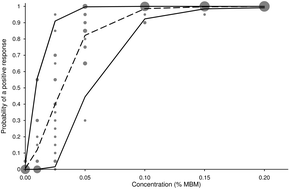A protocol for the validation of qualitative methods of detection†
Abstract
This paper presents a draft protocol for analyzing the results of validation studies for qualitative methods of detection which is designed to meet three competing goals: (1) to give correct answers, (2) have a broad scope of application, and (3) be accessible to a wide range of users. The draft protocol can be applied to the validation of methods by collaborative trial or to single-laboratory studies. The protocol produces an estimate of the probability of a positive response with a prediction interval within which 95% of laboratories (or analytical runs) are expected to fall when the method is applied in practice. The interval is calculated from the observed reproducibility (or within-laboratory reproducibility) standard deviation. Then a simple plot of prediction intervals for the probability of detection against the concentration of


 Please wait while we load your content...
Please wait while we load your content...